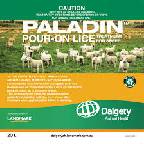
Most anthelmintics have withholding periods if milk or meat from treated animals is intended for human consumption; the specific requirements for each must be observed. Of the benzimidazoles, thiabendazole is absorbed and excreted most quickly; fenbendazole, oxfendazole, and albendazole are absorbed and excreted over a longer period, which necessitates withholding periods of 8-14 days before slaughtering for meat, and 3-5 days before milking for human consumption. Other members of the group have withholding periods between these extremes, but withholding periods are longer for bolus formulations.
A similar relationship between the rate of metabolism and activity against immature parasites also exists with certain fasciolicides. Closantel, rafoxanide, and nitroxynil bind more strongly to blood proteins than does oxyclozanide, and therefore remain in the blood for longer periods. While this greater persistence is associated with greater activity against immature liver flukes, the withholding period for slaughter is also longer: 21-77 days for closantel, rafoxanide, and nitroxynil, compared with 3-14 days for oxyclo-zanide. The low plasma-protein binding of diamfenetide, coupled with the rapid excretion of its active metabolite, necessitates only a short withdrawal time. Similarly, withholding periods for milk vary widely. Closantel and nitroxynil cannot be used in lactating animals when milk is intended for human consumption, while oxyclozanide has a withdrawal time of only 60 hr.
Levamisole and morantel are rapidly excreted; thus, withholding periods for meat are short, and frequently there is no, or only a short, withholding period for milk. However, in some countries levamisole cannot be used in lactating animals when milk is intended for human consumption.
Ivermectin and doramectin are excreted in milk and are not recommended when milk is intended for human consumption; commensurate with the long period of activity of macrocyclic lactones, ivermectin, abamectin, doramectin, and moxidectin have significant withholding periods before slaughter (eg, 35 days), which vary with the formulations and local regulations. Residual concentrations of moxidectin in milk after topical administration are below threshold limits resulting in no milk withholding period in many countries. The chemical structure of the macrocyclic lactone molecule can be manipulated to change the milk partitioning coefficients in lactating dairy animals. This led to the development of eprinomectin, of which only 0.1% of the total dose is eliminated in the milk, resulting in no withholding period for milk worldwide.



